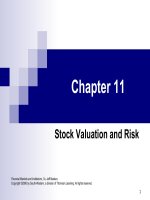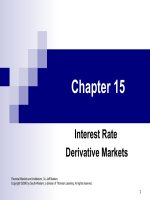Thị trường tài chính và các định chế tài chính_ Chapter 07
Bạn đang xem bản rút gọn của tài liệu. Xem và tải ngay bản đầy đủ của tài liệu tại đây (316.81 KB, 38 trang )
1
Chapter 7
Bond Markets
Financial Markets and Institutions, 7e, Jeff Madura
Copyright ©2006 by South-Western, a division of Thomson Learning. All rights reserved.
2
Chapter Outline
Background on bonds
Treasury and federal agency bonds
Municipal bonds
Corporate bonds
Institutional use of bond markets
Globalization of bond markets
3
Background on Bonds
Bonds represents long-term debt securities that are
issued by government agencies or corporations
Interest payments occur annually or semiannually
Par value is repaid at maturity
Most bonds have maturities between 10 and 30 years
Bearer bonds require the owner to clip coupons attached
to the bonds
Registered bonds require the issuer to maintain records
of who owns the bond and automatically send coupon
payments to the owners
4
Background on Bonds (cont’d)
Bond yields
The issuer’s cost of financing is measured by the yield to
maturity
The annualized yield that is paid by the issuer over the life of the
bond
Equates the future coupon and principal payments to the initial
proceeds received
Does not include transaction costs associated with issuing the bond
Earned by an investor who invests in a bond when it is issued and
holds it until maturity
The holding period return is used by investors who do not hold a
bond to maturity
5
Treasury and Federal Agency
Bonds
The U.S. Treasury issues Treasury notes
or bonds to finance federal government
expenditures
Note maturities are usually less than 10 years
Bonds maturities are 10 years or more
An active secondary market exists
The 30-year bond was discontinued in
October 2001
6
Treasury and Federal Agency
Bonds (cont’d)
Treasury bond auction
Normally held in the middle of each quarter
Financial institutions submit bids for their own accounts
or for clients
Bids can be competitive or noncompetitive
Competitive bids specify a price the bidder is willing to pay
and a dollar amount of securities to be purchased
Noncompetitive bids specify only a dollar amount of securities
to be purchased
7
Treasury and Federal Agency
Bonds (cont’d)
Treasury bond auction (cont’d)
The Salomon Brothers scandal
In a 1990 bond auction, Salomon Brothers purchased 65
percent of the bonds issued (exceeding the 35 percent
maximum)
Salomon resold the bonds at higher prices to other institutions
In August of 1991, the Treasury Department temporarily
barred Salomon Brothers from bidding on Treasury securities
In May 1992 Salomon paid fines of $190 million to the SEC
and Justice Department
Salomon created a reserve fund of $100 million to cover
claims from civil lawsuits
8
Treasury and Federal Agency
Bonds (cont’d)
Trading Treasury bonds
Bond dealers serve as intermediaries in the secondary
market and also take positions in the bonds
30 primary dealers dominate the trading
Profit from the bid-ask spread
Conduct trading with the Fed during open market operations
Typical daily volume is about $200 billion
Online trading
TreasuryDirect program ()
9
Treasury and Federal Agency
Bonds (cont’d)
Treasury bond quotations
Published in financial newspapers
The Wall Street Journal
Barron’s
Investor’s Business Daily
Bond quotations are organized according to their maturity, with
the shortest maturity listed first
Bid and ask prices are quoted per hundreds of dollars of par value
Online quotations at
/> 10
Treasury and Federal Agency
Bonds (cont’d)
Stripped Treasury bonds
One security represents the principal payment and a
second security represents the interest payments
Investors who desire a lump sum payment can choose the PO
part
Investors desiring periodic cash flows can select the IO part
Degrees of interest rate sensitivity vary
Several securities firms create their own versions of
stripped securities
Merrill Lynch’s TIGRs
The Treasury created the STRIPS program in 1985
11
Treasury and Federal Agency
Bonds (cont’d)
Inflation-indexed Treasury bonds
In 1996, the Treasury started issuing inflation-indexed
bonds that provide a return tied to the inflation rate
The coupon rate is lower than the rate on regular
Treasuries, but the principal value increases by the
amount of the inflation rate every six months
Inflation-indexed bonds are popular in high-inflation
countries such as Brazil
12
Computing the Interest Payment
of an Inflation-Indexed Bond
A 10-year bond has a par value of $1,000 and a
coupon rate of 5 percent. During the first six
months after the bond was issued, the inflation
rate was 1.3 percent. By how much does the
principal of the bond increase? What is the
coupon payment after six months?
65.50$$1,0135%Payment Coupon
013,1$1.013$1,000Principal
=×=
=×=
13
Treasury and Federal Agency
Bonds (cont’d)
Savings bonds
Issued by the Treasury
Have a 30-year maturity and no secondary market
Series EE bonds provide a market-based interest rate
Series I bonds provide a rate of interest tied to inflation
Interest on savings bonds is not subject to state and local taxes
Federal agency bonds
Ginnie Mae issues bonds and purchases mortgages that are
insured by the FHA and the VA
Freddie Mac issues bonds and purchases conventional
mortgages
Fannie Mae issues bonds and purchases residential mortgages
14
Municipal Bonds
Municipal bonds can be classified as either general
obligation bonds or revenue bonds
General obligation bonds are supported by he municipal
government’s ability to tax
Revenue bonds are supported by the revenues of the project for
which the bonds were issued
Municipal bonds typically pay interest semiannually, with
minimum denominations of $5,000
Municipal bonds have a secondary market
Most municipal bonds contain a call provision
15
Municipal Bonds (cont’d)
Credit risk
Less than .5 percent of all municipal bonds
issued since 1940 have defaulted
Moody’s, Standard and Poor’s, and Fitch
Investor Service assign ratings to municipal
bonds
Some municipal bonds are insured against
default
Results in a higher cost for the investor









